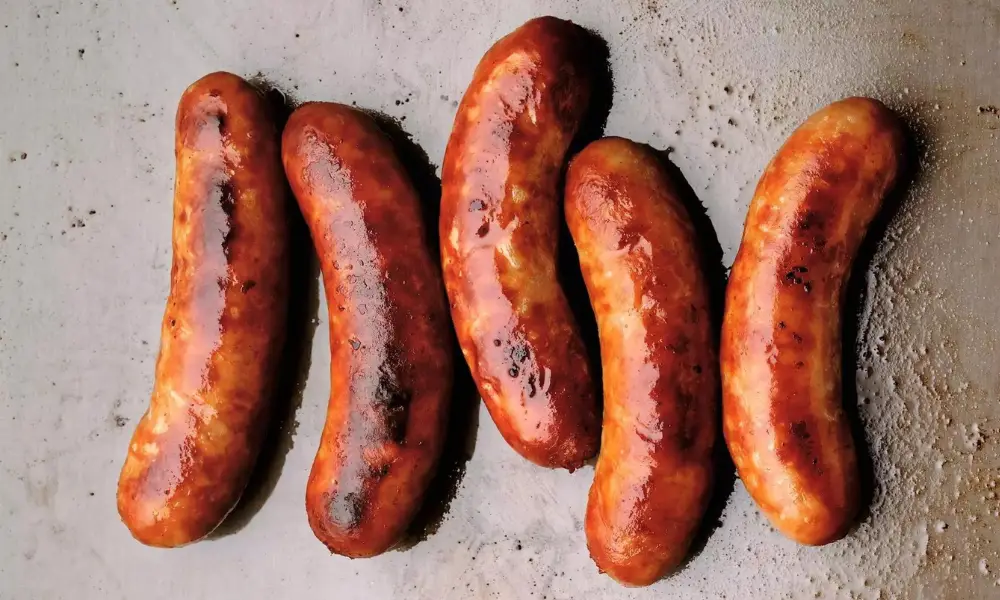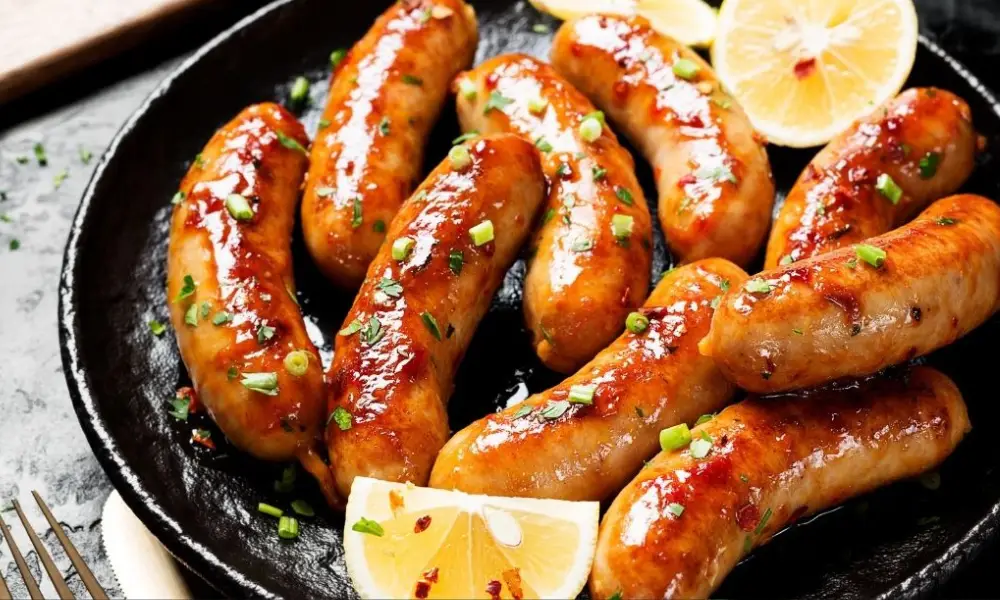You might wonder how safe it is to keep cooked sausages in the fridge and when you should eat them to reduce the chance of food waste or food illness. Knowing in advance will help you keep food correctly and avoid consuming it when it is unsafe.

Sausages are adaptable, simple to prepare, widely accessible, and frequently affordable. However, getting sick is simple if you leave cooked sausage in the refrigerator for too long. In this article, I’ll explain how long cooked sausage is in the fridge so they don’t go wrong and you stay safe.
How Long do Cooked Sausages Last in the Refrigerator?
If your cooked sausages aren’t pre-cooked, you should be able to keep them for approximately two weeks unopened and about a week after opening in your refrigerator. Otherwise, cooked sausages typically last for three to four days.
To reduce the risk of food illness, discard the sausages after this period. Sausages come in various varieties, including cured, smoked, pre-cooked, and fresh. Please ensure you know the type you are working with before storing it because they have different storage estimates.
Once cooked, fresh sausages keep in the refrigerator for about three to four days. In the fridge or a cool pantry, cured and smoked sausages should keep for three weeks or longer. Pre-cooked sausages typically last for two weeks in the refrigerator if they haven’t been opened.
Always verify the suggested storage guidelines on the packet regardless of the type of meat you are working with. If it says to use it within two days of opening, abide by this advice.
You will better predict how long the sausage will last and how to preserve it if you know what kind of sausage you have purchased. Meats that have been cured or smoked will always keep longer, and it should be safe to keep them in storage for weeks, especially if they are kept cool.
Here are some suggestions to ensure proper sausage storage and reduce the likelihood of spoilage:
- To prevent bacteria from growing or flourishing, keep your cooked sausages in an area of the refrigerator that is consistently 40 degrees Fahrenheit cold.
- As with most meats, you are preparing the meat is typically the first step in proper food storage. Ensure your sausages are cooked to an internal temperature of 160 degrees Fahrenheit. Bacteria that can cause food-borne diseases are eliminated at this temperature.
- When placing or removing your sausages from the refrigerator, use clean hands or a clean utensil.
- Keep cooked sausages in your refrigerator from any raw or undercooked food. The possibility of contamination is decreased.
- Sausage that has been cooked will keep in the fridge for four days. Keep them in your freezer for up to 3 months if you need to keep them for a more extended period.
- Place cooked sausages frozen in the refrigerator to defrost until they are soft enough to heat.
- It’s simple to forget where your cooked sausages were stored. Therefore, identify the container with the date you placed the cooked sausages, whether you’re putting them in the freezer or refrigerator.
Do Fresh Sausages Need to be Kept in the Fridge?
Yes, both before and after cooking, fresh sausages must be kept in the refrigerator. To stay fresh, links are safe to eat; they should be cooked within one or two days. Any leftovers should then be chilled and placed right back into the refrigerator.
These sausages should be stored in airtight containers or their original packaging. The meat will last longer as a result of the reduced airflow. They might not keep as well if you store them in the refrigerator on a plate or in an exposed container; instead, you should consume them more quickly.
Fresh sausages shouldn’t be kept at room temperature or in a cool cabinet. The links are susceptible to bacterial contamination without preserving smoking or curing and will shortly become dangerous to eat.
All fresh sausages, whether raw or cooked, should be kept below 40 degrees Fahrenheit within two hours. Throw away the sausages if you unintentionally left them out at room temperature for more time than this. After an hour, discard the sausages if the space is hotter than 90 degrees F.
How Should Precooked Sausages be Stored?
Sausage that has already been cooked needs to be refrigerated. Although they should stay longer because of the precooking, they must be kept cold to protect the meat’s quality. They must once more be thrown out and not eaten if you have allowed them to come to room temperature.
When not in use, keep precooked sausages in their original container. To ensure pre-cooked sausages are safe to eat, many people prefer to cook them again. Any leftovers should be cooled, put in an airtight container, and placed back in the refrigerator as soon as possible if you choose to do this.
Should Sausages be Freeze-Dried?
Yes, as long as it is well past its use-by date, any sausage meat should be OK to freeze. To ensure that there are few bacteria present before it is frozen, place the meat in the freezer as soon as possible.
Although you can, most people don’t because cured or smoked sausages last so long without being frozen in the first place. Sausage that is either fresh or cooked can be frozen and thawed in the refrigerator before use.
Meat that has been at room temperature for more than two hours shouldn’t be frozen. While freezing prevents the spread of bacteria, it does not eliminate existing bacteria or poisons from food. When meat is frozen, it must still be suitable for consumption; otherwise, freezing is ineffective.
What are the Signs that Sausages are Bad?
- When sausages become unsafe to consume, they typically have a slimy feel, and this is because germs will destroy the structure of the meat. A sausage’s outside can be gently poked to see if this has occurred.
- Be careful that rotten sausages typically have a terrible scent as well. If some sausages you’ve cooked don’t smell properly, discard them rather than eat them. Similar to that, throw them away if they have surface mold specks or if their color has altered.
- Even cured meat eventually goes wrong, so if you have some that have been sitting about for a while, make sure you check to see if it is safe to eat before you eat it. Examine the surface, take in the fragrance, feel the texture, and, if in doubt, throw it away.
- Avoid eating meat if you are doubtful about it because it may contain unpleasant microorganisms that could make you very unwell. Instead of putting yourself and others at risk of getting sick with spoiled meat, it is best to throw it out and buy new.
What are Various Kinds of Sausages?
There are many different kinds of sausage available. I’ve frequently stood in the supermarket’s refrigerated department and counted the number of sausages offered. What varieties of sausages are there? Here is a list to aid you in selecting the proper sausage. Fresh, already cooked, smoked, and cured sausages are the four different varieties.
Sausages that have not been previously cooked are referred to as “fresh sausages.” They are spiced and seasoned ground meat, which can be pork, beef, chicken, or turkey. Some may also include herbs. Then a casing is filled with this mixture. Typically, pork intestines are used as the casing. Fresh sausages must be kept in the freezer until you’re ready to cook them.
- Bratwurst, Italian sausage, breakfast patties (yes, they qualify as fresh sausages), and Mexican chorizo are a few well-known varieties.
- Sausages that are still fresh can be grilled or fried, and some sausages can be cooked briefly in water before being fried in their oil once the oils have separated. If you do this, poke their skins with a fork first to prevent them from exploding out of their shells.
- Sausages that have been “pre-cooked” have already been cooked when placed in their casings, as the name suggests. To enjoy the full flavor of these sausages, you must cook them after purchasing. The majority of pre-cooked sausages have thicker, more durable casings.
- Hotdogs, Hungarian, frankfurters, bratwurst, Bierwurst, and bologna are a few well-known pre-cooked sausage varieties.
- These sausages can be broken up and incorporated as the main ingredient in other recipes, broiled, grilled, or pan-fried. These sausages are not considered raw meat because they have already been cooked so that you may prepare them very quickly.
- Smoked sausages – Because they are smoked before being sold, they are also pre-cooked. These sausages are hung in smokehouses where they roast and flavor them using charcoal and wood bits placed on top of the coal bed.
- The French andouille, American andouille, and kielbasa are a few well-known varieties of smoked sausage.
- Slice and reheat smoked sausages to serve. They work well as a sandwich filling, a pizza topper, and soup.
- Sausages that have been “cured” are what their name suggests. Meat is preserved through the process of curing, which uses salt. These cured sausages started as fresh sausages that were salted and dried for weeks. Curing renders the meat inhospitable to a variety of pathogenic bacteria. It is known as salumi in Italy and charcuterie in France.
- The Thai Isaan sausage, Spanish Chorizo, Pepperoni, and Mortadella are a few well-known varieties of cured sausages.
- Before serving, cured sausages may or may not be cooked. As with other cured meats, it is better to slice them thinly. They taste wonderful on a cheese platter, in sandwiches, or as appetizers.
- If you have any fresh, pre-cooked, and smoked leftovers from the first three sausages, they must all be kept in the refrigerator. For weeks, cured sausages can be stored at room temperature, and other types of sausages must only be stored in the fridge for a maximum of four days.
What to do with Remaining Cooked Sausages?
Food rotting is a considerable problem in many nations. 1.5 million sausages are thrown away annually in the UK alone (a country that consumes 175,000 tonnes of sausages annually!). That much spoiling is shocking. Consequently, save those cooked sausages that are leftover. We now know they can be kept in the refrigerator for four days.
Here are several suggestions for repurposing cooked sausages that have been grilled, fried, or broiled.
- Traybakes. Make traybakes with any leftover sausages. Making traybakes is relatively easy, giving leftover cooked sausages an entirely new flavor. Chop up your sausages and add any desired vegetables, such as beans, carrots, or corn. Tomato sauce, herbs, and spices should be added. Bake it in the oven until the vegetables are tender.
- Pasta. Sausage leftovers should be chopped and combined with tomato sauce or olive oil. Garlic, basil, tomatoes, and parmesan cheese should all be added. Add any cooked pasta type to the sauce and top with more cheese. Your sausages’ flavor
- Casseroles. Although they work well with most cooked leftover sausages, chorizos create delicious soups. Add some spinach, green peas, and diced tomatoes, according to taste. You can either add tomato sauce or fresh, chopped tomatoes and water. Stew the vegetables until they are done.
Conclusion
Don’t throw away sausages you can’t eat because you cooked too much. Sausage that has been cooked will keep in the refrigerator for four days, and it must be appropriately preserved at a steady 40 degrees Fahrenheit.
To maintain freshness and prevent infection, put them in shallow, airtight containers or wrap them in sturdy aluminum foil. Keep sausages in the freezer if you need to keep them for a more extended period.

